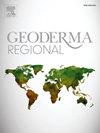Management strategies for regenerative agriculture based on the assessment of soil fertility in northern Mozambique
IF 3.1
2区 农林科学
Q2 SOIL SCIENCE
引用次数: 0
Abstract
Despite having high potential for agricultural production, the maize yield in northern Mozambique is low due to the depletion of macronutrients in soil. Soil fertility analysis serves as a basis for developing regenerative agriculture (RA) strategies. For best results, RA practices suitable to the type of soil in northern Mozambique should be selected and applied. Hence, in this study, we examined soil characteristics and their relationship with maize yield across 196 locations in the Nacala Corridor of northern Mozambique. The results revealed significant variation in soil fertility, which was primarily influenced by organic matter, clay content, and nutrient availability. Cluster analysis identified three distinct soil fertility groups: low-fertility soils were found in the eastern region, with reduced maize yield, whereas high-fertility soils were predominant in the western and central-southern regions, which produced better yield. These findings highlight the importance of detailed soil analysis for the development of targeted soil management strategies, such as conservation agriculture and integrated soil fertility management, that can enhance nutrient retention, increase organic matter content, and improve crop yield. This study provides essential insights for smallholder farmers and policymakers to implement sustainable agriculture and improve long-term productivity in northern Mozambique.
求助全文
约1分钟内获得全文
求助全文
来源期刊

Geoderma Regional
Agricultural and Biological Sciences-Soil Science
CiteScore
6.10
自引率
7.30%
发文量
122
审稿时长
76 days
期刊介绍:
Global issues require studies and solutions on national and regional levels. Geoderma Regional focuses on studies that increase understanding and advance our scientific knowledge of soils in all regions of the world. The journal embraces every aspect of soil science and welcomes reviews of regional progress.
 求助内容:
求助内容: 应助结果提醒方式:
应助结果提醒方式:


